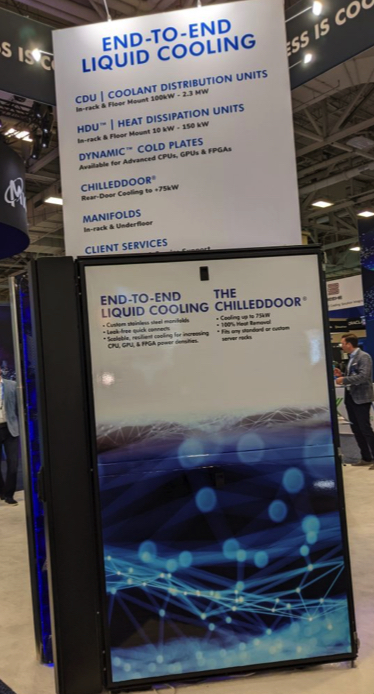SC22 Provides Glimpse into Tomorrow’s Data Center
Supercomputing centers early adopters of technologies soon common in most data centers
This is a Press Release edited by StorageNewsletter.com on November 21, 2022 at 1:02 pm This article, published on November 17, 2022, was written by Ken Clipperton, lead analyst, storage, DCIG, LLC.
This article, published on November 17, 2022, was written by Ken Clipperton, lead analyst, storage, DCIG, LLC.
SC22 Provides Glimpse into Tomorrow’s Data Center
I had the privilege of attending SC22, the supercomputing conference, on November 13–18, 2022, in Dallas, TX.
Supercomputing centers are early adopters of technologies that will soon be common in most data centers. Thus, the sessions I attended, the attendees I spoke with, and the solutions on display in the exhibit hall provided me with an eye-opening glimpse into tomorrow’s data center.
Increasing data center density driving change
Data center density is increasing in multiple dimensions including compute, storage, power, and heat. According to Mitchell Knight of CoolIT, average data average data center power density has quadrupled in the last 10 years. HPC is leading the way, with 45KW per rack becoming common and the Frontier HPC system draws 300KW per rack.
Much of this increase is driven by advances in CPUs and GPUs. For example, Intel’s 3rd gen Xeon processors have a maximum thermal design (TDP) of 280W per processor, and its 4th gen Xeon processors can draw up to 350W per processor. NVIDIA’s A100 GPU has maximum TDP of 300W, and its new H100 draws up to 700W per processor.
You may not need more data center space to keep up with your performance and capacity demands, but you will need more power and cooling capacity delivered to your data center.
These increases require changes in data center infrastructure, including the technologies we include in the data center and perhaps where we run our workloads.
Liquid cooling for data center hot at SC22

Advances in processors are driving the need for liquid cooling. Happily, a complete ecosystem appears to be in place to address the increasing heat density in the data center. Many vendors displayed multiple approaches to liquid cooling in the exhibit hall. These include immersion, direct-to-chip, and back-of-rack solutions.
Many of these liquid cooling solutions exchange heat with facility water to carry away the heat, while others dissipate heat into the air. One Stop Systems displayed a self-contained “HPC at the edge” that uses full immersion to cool a quad-GPU system.
Data Tsunami quantified
HPC requires vast amounts of data capacity and velocity. One attendee I spoke with is responsible for managing an infrastructure that is generating 2PB of genomics data daily. They process that data down to 100TB they need to persist each day.
In a meeting with Vast Data executives, they said their average customer has 10PB of Vast storage in place with 99.999%+ availability. Some of Vast Data’s customers have hundreds of petabytes of VAST storage in place.
One of these Vast customers is EMBL-EBI. Raphael Griman, Compute Team Lead for EMBL-EBI, said they are currently storing more than 250PB of public science data and expect to cross the exabyte boundary within a year. That means they will add an average of 2PB of data to their environment every day.
Griman said they have had zero storage downtime in the 3 years they have been using Vast Data. EMBL-EBI is consolidating from 7 file systems down to just two, with Vast storage providing the engine for that consolidation.
Necessity of intelligent management
Massive amounts of data can create massive logistical challenges that start with providing a landing place for the data and the bandwidth required to move the data to storage. Automation and smart data placement are essential to controlling costs and deriving value from data at scale.
I spoke with 2 vendors that are addressing the multi-petabyte data management challenge at SC22. Hammerspace creates what it terms a “global data environment” through intelligent metadata management. It moves and aggregates metadata from all an organization’s filers to provide a global view and unified management plane for all the unstructured data stored on those systems.
Arcitecta’s Mediaflux metadata database technology provides policy-driven data management to enable data and business resilience. One application of the Mediaflux technology is the high-speed transfer of data across global networks. This capability was recently awarded the Most Complete Solution and Best Software Architecture by the International Data Mover Challenge (DMC) at Supercomputing Asia 2022 (SCA22).
Composable architecture
Another kind of Liqid was on display in the exhibit hall. Liqid provides a composable infrastructure solution based on PCIe fabric and its software for pooling and composing PCIe-attached devices. Their technology provides a preview of the advances that CXL is bringing to data center architecture.
Realm of possible expanding
Unconventional thinking is expanding the realm of the possible. If sustainability through the use of renewable energy is important to your organization, you may want to identify workloads that are batch oriented, as is true of many scientific workloads, and move that processing to where renewable energy is produced rather than moving more electricity to your data center.
Lancium Compute now offers high-performance computing as a service (HPC PaaS) in data centers powered by 100% renewable energy. Lancium is placing its compute near in regions with more renewable energy capacity than transmission capacity. Lancium Compute purchases renewable energy at the lowest possible cost by pausing jobs during periods of high demand or low renewable energy production.
Takeaways
Supercomputing is showing the way into the future for the data center. You may not need more data center space to keep up with your performance and capacity demands, but you will need more power and cooling capacity delivered to your data center.
Read also this article from Forbes:
Super Computing And Storage On Earth And In Space













 Subscribe to our free daily newsletter
Subscribe to our free daily newsletter

